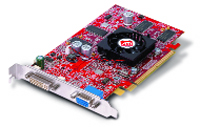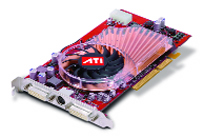Covering All the Bases - ATI FireGL V Series and X3-256 3D Graphics Boards
New PCI Express and AGP accelerators meet every 3D need.
Latest News
December 4, 2001
By David Cohn
After hearing for years about a new PC graphics hardware standard, thePCI Express bus was finally announced last summer. Since then, computercompanies have shipped new systems based on PCI Express and graphicscard manufacturers have released a myriad of new hardware designed forthe new bus architecture. At the same time, most of these companieshave also released a number of high-end AGP-based boards designed towring the last ounce of performance from slightly older systems somedesigners are still working on.
ATI Technologies was the first of the graphics card manufacturers toannounce PCI Express-based boards, with the introduction of its newFireGL Visualization series. But unlike arch rival NVIDIA (nvidia.com),which at the time of the PCI Express release announced that it did notplan to introduce any more AGP-based boards, ATI also released newAGP-based boards. Over the past few months, we’ve tested almost all ofthe company’s new FireGL V series boards as well as the AGP-basedFireGL X3-256.
Range of Capabilities
All four of the boards in ATI’s new Visualization series are true PCIExpress boards designed for the x16 lane architecture. The boards varyin memory size, interface, visual processing unit (VPU—the graphicschip at the heart of the board), and output capabilities.

Figure 1: ATI Technologies’new entry level FireGL V3100 PCI Express graphics card offers 128MB ofDDR unified graphics memory and a 128-bit interface.
At the entry level, the FireGL V3100 ($249 SRP/$200 average streetprice) provides 128MB of DDR unified graphics memory with a 128-bitinterface (see Figure 1, above). Its VPU, which is based on anoptimized version of ATI’s previous architecture, provides two geometryengines with four pixel pipelines. While the board offers two videoconnectors, to reduce cost it provides a single digital DVI connectorand an analog VGA connector. The VPU’s 6.4GBps bandwidth delivers 200million triangles and 1.6 billion pixels per second. The V3100 is theonly ATI board covered here that we did not put through its paces.

Figure 2: The FireGL V3200 PCIExpress graphics card from ATI Technologies has a pair of DVI-Iconnectors and a stereo 3D connector. It’s rated at 250 milliontriangles and 2 billion pixels per second.
The FireGL V3200 ($399 SRP/$290 street) represents a small step up fromthe base-level board (see Figure 2, above). Also based on existing VPUtechnology, it comes equipped with the same amount of memory as theV3100, but provides two DVI-I connectors. The V3200 also offers astereo 3D connector. With a memory bandwidth of 12.8GBps, the V3200 israted at 250 million triangles and 2 billion pixels per second.
The mid-range FireGL V5100 ($799 SRP/$585 street) ups the ante yetagain (see Figure 3, below). This time, the 128MB of DDR unified memoryuses a 256-bit interface and the VPU, based on an all-new architecture,uses 12 pixel pipelines and 6 geometry engines. Two DVI-I connectorsagain provide dual-screen support. With a memory bandwidth of 22.4GBps,the V5100’s performance increases to 675 million triangles and 5.4billion pixels per second.
At the top of the Visualization series, the FireGL V7100 ($1,099SRP/$810 street) comes with 256MB of GDDR3 unified graphics memorysupported through a 256-bit interface (see Figure 4, below). (Editor’s note: GDDR3 is an acronym meaning third generationdouble data rate—DDR—dynamic random access memory—DRAM—for graphics.)

Figure 3: ATI Technologies’FireGL V5100 PCI Express graphics card has 128MB of DDR memory and usesa 256-bit interface. It pumps out 675 million triangles and 5.4 billionpixels per second.
The new ATI VPU provides 16 pixel pipelines and 6 geometry engines.Dual displays are again supported via two DVI-I outputs, with bothcapable of maximum resolutions up to 2048 3 1536 pixels per display.But the V7100 also supports dual link for ultra-high resolution9-megapixel displays, providing a maximum resolution of 3840 3 2400when connected to a single ultra-high-resolution display. The board’s28.8GBps bandwidth yields rated performance of 750 million trianglesand 8 billion pixels per second. Its higher power consumption meansthat the V7100 requires the use of a 6-pin 12V power cable.
For those looking for a relatively affordable high-end AGP-basedgraphics accelerator for an existing system, the FireGL X3-256 may justfit the bill (see Figure 5, below). It matches the $1,099 suggestedretail price of the V7100 (although its street price is a bit lower)and nearly matches its performance.

Figure 4: With 256MB of GDDR3memory and a 256-bit interface, the top-of-the-line FireGL V7100 PCIExpress graphics card from ATI Technologies provides a maximumresolution of 3840 3 2400.
The X3-256 comes with 256MB of memory connected through a 256-bitinterface, although it uses DDR rather than the GDDR3 memory suppliedin the V7100. The 28.8GBps memory bandwidth also matches that of theV7100. The VPU is similar, with 6 geometry engines and 12 pixelpipelines. And like the V7100, the X3-256 provides two DVI-I connectorsto support any combination of digital flat panel and analog displays atresolutions up to 2048 3 1536; and one of the DVI-I connectors supportsdual-link for ultra-high-resolution displays. Graphics performancecomes close to that of the V7100, delivering 750 million vertices persecond. But the AGP interface shows its limitations here, with theFireGL X3-256 only able to pump out 5.4 billion pixels per second. TheX3-256 requires the use of a 4-pin power cable, typical forhigher-powered AGP accelerators.

Figure 5: One of the last of a breed? The FireGL X3-256 from ATI Technologiesis a high-endAGP-based graphics card.
Benchmarking the Boards
We installed the V3200, V5100, and V7100 in a Hewlett Packard (hp.com)HP xw4200 workstation equipped with 3.4GHz CPU and 2GB of DDR2 memory.This is the same system reviewed in the August 2004 issue of DE. Since the system was originallyprovided with an NVIDIA Quadro FX 1300 graphics board, we’ve includedit in our benchmark results for comparison purposes.
To test the FireGL X3-256 board, we installed it in a 3.2GHz HP xw4100workstation equipped with 512MB of DDR RAM. This system, originallysupplied with an NVIDIA Quadro4 980 XGL graphics board, was previouslyreviewed by Desktop Engineering in September 2003 (p. 10).
In the June2004 issue of DE (p. 30), we also tested an NVIDIA Quadro FX1100 inthis same system, so we have included both of those benchmark testresults for comparison as well. To further aid comparison, we retestedall of the accelerators using the latest version 8.01 of theSPECViewperf benchmark (spec.org) as well as version 7.1.1 (see Table 1, click here to download an Excel file).
All of the new ATI FireGL boards are fully certified with most MCAD andDCC (digital content creation) applications. All use ATI’s unifieddriver, with full support for OpenGL 1.5 plus extensions and DirectX9.0. And all include ATI’s latest shader, Z-buffer, and antialiasingtechnology. Drivers are available for Windows 2000, Windows XP, andLinux, including 64-bit versions. All of the ATI boards come with a3-year limited product repair/replacement warranty.
More MCAD ChoicesWhile NVIDIA has been the dominant player in the workstation graphicsarena for many years, these new graphics accelerators from ATI provethat this company has caught up. The new ATI FireGL boards offer a widerange of choices, with prices starting below $200. In terms of pricefor performance, ATI Technologies appears to have the edge, deliveringsomewhat better benchmark results for slightly less money across itsentire product line. One thing is for certain: MCAD users now have lotsof worthwhile choices.
David Cohn is a computer consultant and technical writer based inBellingham, Washington, and has been benchmarking PCs since 1984. He’sa contributing editor to Desktop Engineering, the Editor-in-Chief ofEngineering Automation Report (eareport.com), and CADCAMNet(cadcamnet.com) published by Cyon Research (cyonresearch.com), and theauthor of more than a dozen books. Send your feedback about thisarticle through e-mail by clicking here. You can also visitDavid’s website at dscohn.com.
Product Information
ATI Technologies, Inc.
Markham, ONT
Requirements
Intel Pentium 4/Xeon, AMD Athlon/Opteron, or compatible; Linux,Microsoft Windows 2000, Windows XP, or Windows XP 64-bit Edition; PCIExpress x16 slot (for FireGL V series) or AGP 8X/4X slot (for FireGLX3-256); 128MB of system memory (256MB or more recommended); 300W orgreater power supply (recommended).
Pricing
ATI FireGL V3100 $249 ($200, average street)
ATI FireGL V3200 $399 ($290, average street)
ATI FireGL V5100 $799 ($585, average street)
ATI FireGL V7100 $1,099 ($810, average street)
ATI FireGL X3-256 $1,099 ($760, average street)
Subscribe to our FREE magazine, FREE email newsletters or both!
Latest News
About the Author
David Cohn is a consultant and technical writer based in Bellingham, WA, and has been benchmarking PCs since 1984. He is a Contributing Editor to Digital Engineering, the former senior content manager at 4D Technologies, and the author of more than a dozen books. Email at [email protected] or visit his website at www.dscohn.com.
Follow DE






